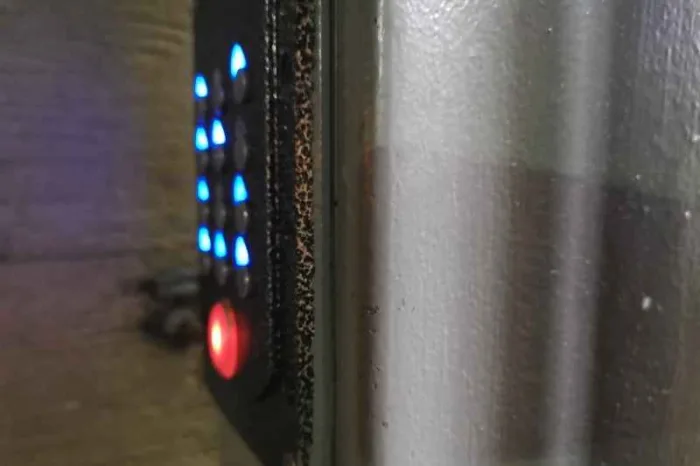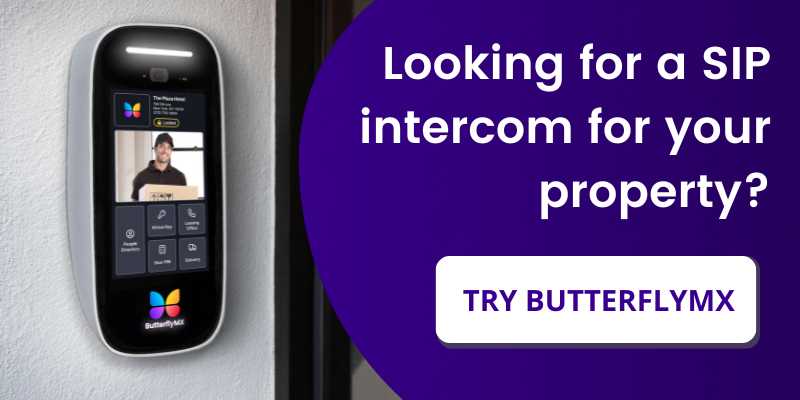Key takeaways:
- SIP intercoms allow tenants to communicate with visitors remotely via smartphones, offering a modern, seamless access control solution.
- These systems reduce installation costs by eliminating the need for extensive wiring, making them a more cost-effective solution for properties.
- Features like video calling and Visitor Passes improve security by ensuring only authorized guests can enter.
- Property staff benefit from web-based dashboards and integration with other management systems, streamlining administrative tasks.
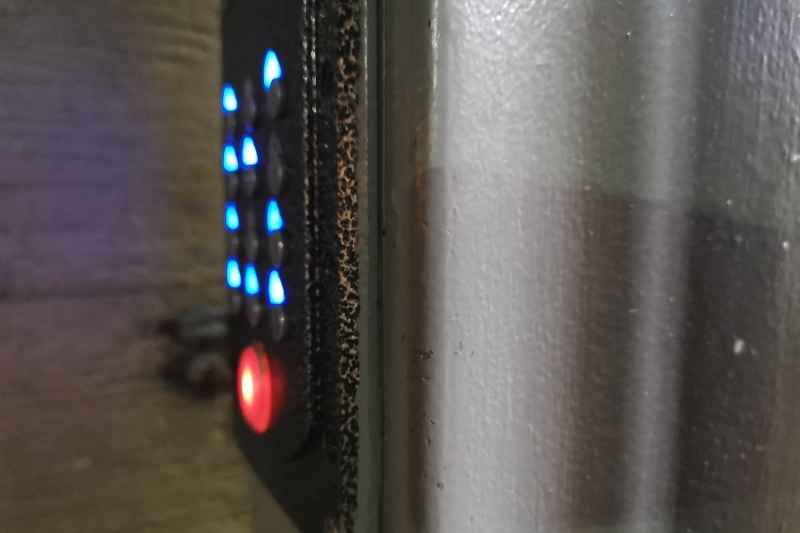
While choosing an intercom for your property might seem simple, the right access control experience can be the difference between receiving your delivery and missing it entirely. The right property technology is becoming increasingly important to prospective and current residential or commercial tenants.
So, it may be time to consider adding a layer of convenience and security to your property by installing an IP intercom system. Read on to learn what SIP intercoms are, how they work, and why a SIP intercom is the best entry system for your building.
This post covers:
- The best SIP intercom
- What is a SIP intercom?
- How does a SIP intercom work?
- Why your building needs a SIP intercom
The best SIP intercom
The best SIP intercoms use the internet’s powerful capabilities, which means they can connect to the latest devices, such as smartphones and even Apple Watches.
ButterflyMX is a SIP intercom that fully utilizes the internet’s potential. By letting residents open doors with their smartphones, ButterflyMX brings your property into the modern age while adding a variety of secure and convenient features for tenants and staff.
Since the ButterflyMX SIP intercom has a camera, tenants and visitors can video chat with each other. This also significantly improves security, ensuring only authorized guests can enter the property. Meanwhile, Visitor Passes provide tenants with seamless access to visitors such as house cleaners and dog walkers. Furthermore, managing package delivery has never been easier thanks to ButterflyMX’s system of delivery PINs and passes for couriers.
For building staff, ButterflyMX’s web-based dashboard has features like an audit trail of all door release events, which helps them better secure the property. The ButterflyMX intercom also integrates with other property management services to create one cohesive smart building ecosystem.
What is a SIP intercom?
A SIP—or Session Initiation Protocol—intercom is an electronic device that uses the Internet to let a building’s tenants communicate with guests seeking entry. It also allows tenants to buzz in their guests without having to physically go to their front door or gate.
SIP intercoms are the next evolution in access control because they transmit data over the Internet. Analog intercoms of the past depended on wiring throughout the building to function, making them expensive to install and limiting them to on-premises use only.
SIP intercom systems are useful for all types of properties, including residential apartments, office complexes, and student housing.
SIP intercoms have four parts:
- Base station. The base station is hardware installed at the property’s entrance. One of its most important components is a SIP intercom speaker, which allows visitors to speak with a building tenant through the base station.
- Server. An intercom SIP server is a central hub that keeps a database of access credentials and manages the entire intercom system. This server was previously installed on the property near the base station. Many modern video intercoms use the cloud, eliminating buildings needing to purchase and maintain a server.
- Substations. Substations are the hardware that tenants use to talk to visitors. They can take many different forms. For example, a substation might be hardware mounted in a tenant’s unit, a SIP intercom phone, or even a resident’s smartphone.
- Door strike. A tenant who wants to grant entry to their visitor presses the ‘door open’ button on their substation, sending a signal to the door to unlock. Door strikes can be electric or magnetic.
Watch how ButterflyMX works:
How does a SIP intercom work?
SIP intercoms use the internet to transmit audio and video data between a building tenant using a substation and a visitor at a base station. SIP helps ensure that the transmitted data arrives successfully and in the correct order.
The Session Initiation Protocol (SIP) is one type of Internet protocol, a set of rules that computers use to send data over the Internet. SIP is designed to enable two computers to initiate and shut down a data transmission session.
Intercom providers may also use VoIP, or Voice over Internet Protocol, to transmit audio or video data specifically. Thus, the term ‘VoIP intercom’ is commonly used as well. While each protocol’s technical details differ, the terms ‘IP intercom,’ ‘VoIP intercom,’ and ‘SIP intercom’ are generally interchangeable.
Regardless of their name, internet-based intercoms provide building residents, staff, and visitors with features like remote property access, video capabilities, and mobile apps.
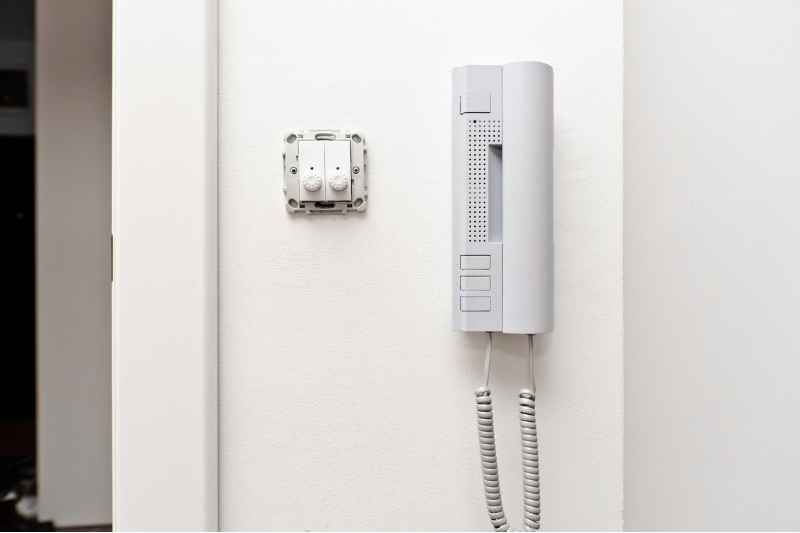
The relationship between SIP and VoIP
We’ve mentioned that SIP intercoms are sometimes called VoIP intercoms. This is because the two protocols, SIP and VoIP, are often used together.
VoIP, or Voice over Internet Protocol, is actually an umbrella term for a collection of protocols that work together to ensure the audio data from a call is transferred successfully over the Internet. SIP is only one of these protocols and can act independently. For example, while VoIP only transfers audio or video data, all sorts of computers use SIP to initiate other types of data transfers.
Put simply, whether an IP intercom is classified as a VoIP or SIP intercom will not noticeably differ for tenants, residents, or visitors.
Here’s how a guest contacts a tenant using a SIP intercom:
- Visitor uses base station to select a tenant. Visitors do this by selecting the tenant they’re visiting from a directory in the intercom base station, similar to a SIP doorbell.
- The base station establishes a connection with the intercom substation using the SIP protocol.
- Visitor and tenant communicate. SIP enables data transmission. Meanwhile, the substation and base station can use another protocol, such as VoIP, to transmit data and allow the tenant and the visitor to communicate. SIP video intercoms also allow tenants and visitors to see each other.
- Tenant grants visitor entry. After the tenant presses a button on their substation, the electronic door strike releases and the visitor can enter.
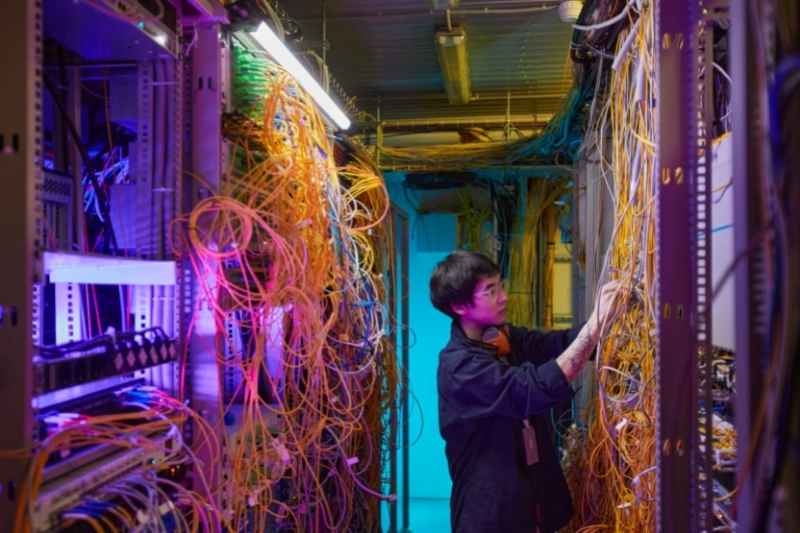
Why your building needs a SIP intercom
Now that you know how a SIP-based door phone works, you can better appreciate the benefits of an internet-powered access control system.
SIP intercom benefits include:
- Wireless capabilities. SIP door intercom base stations and substations can communicate wirelessly. As a result, you’ll save on installation costs since you don’t have to tear down and rebuild walls to lay wiring. And if your property has a gate, installing an SIP gate intercom means you don’t have to dig up the pavement to run outdoor wiring.
- Added functionality. Digital intercoms can store and retrieve large amounts of data at lightning-fast speeds, leading to features that benefit tenants, like Visitor Passes and delivery passes.
- Administrative tools for staff. Some SIP intercoms simplify administrative tasks for property staff. They provide features like web-based dashboards and integrations with other property management services.
